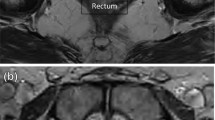Abstract
Prior studies have shown that dose-escalated radiation therapy for prostate cancer improves clinical outcomes. However, this is associated with increased rectal toxicity. Hydrogel spacer for prostate cancer therapy is an effective way of decreasing rectal toxicity in the late post-therapeutic stages. In some occasions, the gel spacer may not be placed symmetrically between the rectum and prostate. There are several forms of a malpositioned spacer, including lateral displacement, rectal wall infiltration, and prostate capsule infiltration. This manuscript is aimed at evaluating appropriately positioned and malpositioned gel spacers, primarily via magnetic resonance imaging. There are limited educational imaging guides that address what radiologists should evaluate on post-spacer placement imaging. This pictorial review will specifically evaluate post-injection pitfalls such as asymmetry, rectal wall infiltration, and subcapsular injection.






Similar content being viewed by others
References
Vanneste BGL, Hoffmann AL, van Lin EN, et al. (2016) Who will benefit most from hydrogel rectum spacer implantation in prostate cancer radiotherapy? A model-based approach for patient selection. Radiother. Oncol. 121(1):118–123. https://doi.org/10.1016/j.radonc.2016.08.026
Hatiboglu G, Pinkawa M, Vallee JP, et al. (2012) Application technique: placement of a prostate-rectum spacer in men undergoing prostate radiation therapy. BJU Int. https://doi.org/10.1111/j.1464-410x.2012.11373.x
Uhl M, Herfarth K, Eble MJ, et al. (2014) Absorbable hydrogel spacer use in men undergoing prostate cancer radiotherapy: 12 month toxicity and proctoscopy results of a prospective multicenter phase II trial. Radiat. Oncol. 9(1):96. https://doi.org/10.1186/1748-717x-9-96
Boissier R, Udrescu C, Rebillard X, et al. (2017) Technique of injection of hyaluronic acid as a prostatic spacer and fiducials before hypofractionated external beam radiotherapy for prostate cancer. Urology 99:265–269. https://doi.org/10.1016/j.urology
Hamstra DA, Mariados NF, Shah DK, et al. (2016) Continued benefit to rectal separation for prostate RT: final results of a phase III trial. Int. J. Radiat. Oncol. Biol. Phys. 96(5):939. https://doi.org/10.1016/j.ijrobp.2016.09.050
Mariados N, Sylvester J, Shah D, et al. (2015) Hydrogel spacer prospective multicenter randomized controlled pivotal trial: dosimetric and clinical effects of perirectal spacer application in men undergoing prostate image guided intensity modulated radiation therapy. Int. J. Radiat. Oncol. Biol. Phys. 92(5):971–977. https://doi.org/10.1016/j.ijrobp.2015.04.030
Fischer-Valuck BW, Chundury A, Gay H, et al. (2017) Hydrogel spacer distribution within the perirectal space in patients undergoing radiotherapy for prostate cancer: impact of spacer symmetry on rectal dose reduction and the clinical consequences of hydrogel infiltration into the rectal wall. Pract. Radiat. Oncol. 7(3):195–202. https://doi.org/10.1016/j.prro.2016.10.004
Pinkawa M, et al. (2013) Spacer stability and prostate position variability during radiotherapy for prostate cancer applying a hydrogel to protect the rectal wall. Radiother. Oncol. 106(2):220–224. https://doi.org/10.1016/j.radonc.2012.11.010
Sheridan AD, Nath SK, Huber S, et al. (2017) Role of MRI in the use of an absorbable hydrogel spacer in men undergoing radiation therapy for prostate cancer: what the radiologist needs to know. Am. J. Roentgenol. https://doi.org/10.2214/ajr.17.18026
Author information
Authors and Affiliations
Corresponding author
Ethics declarations
Funding
This study contains no funding.
Conflict of interest
Aaron Rohr declares that he has no conflict of interest. Kyle Werth declares that he has no conflict of interest. Xinglei Shen declares that he has no conflict of interest. Zachary Collins declares that he has no conflict of interest. Shelby Fishback declares that she has no conflict of interest. Jill Jones declares that she has no conflict of interest. Ryan Ash declares that he has no conflict of interest. Vanessa Williams declares that she has no conflict of interest.
Ethical approval
This article does not contain any studies with human participants performed by any of the authors.
Rights and permissions
About this article
Cite this article
Rohr, A., Werth, K., Shen, X. et al. MRI findings of absorbable hydrogel spacer for prostate cancer therapy: a pictorial review. Abdom Radiol 44, 247–251 (2019). https://doi.org/10.1007/s00261-018-1685-y
Published:
Issue Date:
DOI: https://doi.org/10.1007/s00261-018-1685-y




